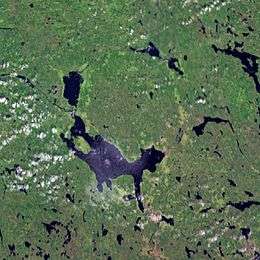Siljan Ring
 Satellite photo of the Siljan Ring. Lake Siljan takes up a large part of the southwestern edge of the now much-eroded crater. | |
| Impact crater/structure | |
|---|---|
| Confidence | Confirmed |
| Diameter | 52 km (32 mi) |
| Age |
376.8 ± 1.7 Ma Frasnian |
| Exposed | Yes |
| Drilled | Yes |
| Location | |
| Coordinates | 61°02′N 14°55′E / 61.04°N 14.92°ECoordinates: 61°02′N 14°55′E / 61.04°N 14.92°E |
| Country |
|
| District | Dalarna |
 Location of the crater in Sweden | |
The Siljan Ring (Swedish: Siljansringen) is a prehistoric impact crater in Dalarna, central Sweden.[1] It is one of the 15 largest known impact craters on Earth and the largest in Europe, with a diameter of about 52 kilometres (32 mi). The impact that created the Siljan Ring occurred when a meteorite collided with the Earth's surface during the Devonian period, about 376.8 ± 1.7 Ma.[2] This coincides around the first Devonian extinction, the Kellwasser Event or Late Frasnian extinction at 376.1 Ma ± 1.6 Ma.[3] The effects of the impact can clearly be seen in the bedrock in the area. The Cambrian, Ordovician and Silurian sedimentary rocks deformed by the impact are rich in fossils.
The area around the Siljan Ring has been the site of recent prospecting for oil and natural gas, though none of the projects has so far been commercially viable. There are large deposits of lead and zinc near Boda at the eastern edge of the Ring.
There are several lakes in the vicinity, the largest of which is Siljan on the south-southwestern edge of the crater, with the smaller Lake Orsa to the west and Skattungen and Ore on the northeastern margin.
Geology
The Siljan Ring consists of an annular outcrop of Lower Paleozoic sedimentary rocks within Proterozoic granites of the Dala series.[4]
Basement rocks
In Dalarna, the basement rocks consist of granites dated as 1.6 billion years old, putting them at the boundary between the Paleoproterozoic and the Mesoproterozoic. They were emplaced shortly after the Svecokarelian orogeny.[5]
Sedimentary rocks
The oldest sedimentary rocks that outcrop in the Siljan area are of Ordovician age. The sequence is dominated by limestone formations with one prominent black shale, the Fjäcka Shale, which is bituminous and has generated petroleum, sourcing the oil found in limestone cavities in the same area.[4] The Ordovician sequence is overlain by rocks of the Llandovery series (Lower Silurian).[6]
Glaciation
During the last ice age the area was covered by a thick icesheet. The bedrock was sculpted by the ice, with the softer Palaeozoic sedimentary rocks being preferentially eroded. These erosional hollows are now occupied by lakes Siljan, Orsa, Skattungen and Ore.[4]
Oil and gas prospecting
In accordance with theories about abiogenic petroleum (that hydrocarbons can be formed without involving material from dead plants and animals), astrophysicist Thomas Gold suggested that there might be major deposits of oil and natural gas in the area. Drilling was carried out in the late 1980s and early 1990s but proved inconclusive.[1][7] Drilling for natural gas was resumed in the late 2000s and continue as of mid-2012. The scientific premise for prospecting of this sort is based on the work of physicist Vladimir Kutcherov, who is cooperating with Igrene, the company financing the drilling operations.[8]
References
- 1 2 Glasby (2006)
- ↑ "Siljan". Earth Impact Database. University of New Brunswick. Retrieved 2017-10-09.
- ↑ J.R. Morrow and C.A. Sandberg (2005). Revised Dating Of Alamo And Some Other Late Devonian Impacts In Relation To Resulting Mass Extinction, 68th Annual Meteoritical Society Meeting (2005)
- 1 2 3 Ebbestad, J.O.R.; Högström A.E.S. (2007). "Ordovician of the Siljan District, Sweden" (PDF). IGCP503 Ordovician Palaeogeography and Palaeoclimate Regional Meeting 2007. Sveriges geologiska undersökning. pp. 7–22. Retrieved 12 July 2012.
- ↑ Kenkmann, T.; von Dalwigk I. (2000). "Radial transpression ridges: A new structural feature of complex impact craters" (PDF). Meteoritics and Planetary Science. Meteoritical Society. 35: 1189–1201. Bibcode:2000M&PS...35.1189K. doi:10.1111/j.1945-5100.2000.tb01508.x. Retrieved 12 July 2012.
- ↑ Bergström, S.M.; Toprak F.Ö.; Huff W.D.; Mundil R. (2008). "Implications of a new, biostratigraphically wellcontrolled, radio-isotopic age for the lower Telychian Stage of the Llandovery Series (Lower Silurian, Sweden)" (PDF). Episodes. 31 (3): 309–314. Retrieved 12 July 2012.
- ↑ Gold, T (July 1992). "The deep, hot biosphere". Proc. Natl. Acad. Sci. U.S.A. 89: 6045–9. Bibcode:1992PNAS...89.6045G. doi:10.1073/pnas.89.13.6045. PMC 49434. PMID 1631089.
- ↑ Bo Joffer, "Igrene förlänger runt Siljansringen, DT.se, 26 June 2012 (in Swedish). Accessed 13 July 2012."
Bibliography
- Glasby, Geoffrey B. (2006), "Abiogenic Origin of Hydrocarbons: An Historical Overview" (PDF), Resource Geology, 56 (1): 85–98, doi:10.1111/j.1751-3928.2006.tb00271.x, ISSN 1344-1698 .
- Gold, Thomas (1992). "The deep, hot biosphere". Proceedings of the National Academy of Sciences. 89: 6045–6049. Bibcode:1992PNAS...89.6045G. doi:10.1073/pnas.89.13.6045. PMC 49434.

